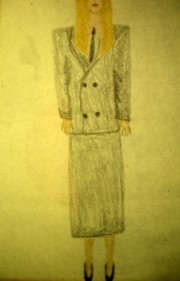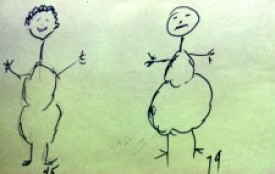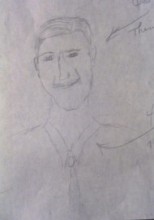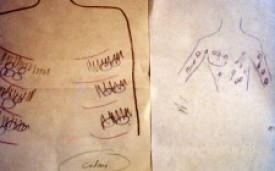Our Society tends to separate conscious thinking from unconscious thinking and assumes that conscious thought is more important, pointing to our spectacular technological advancement as proof. I believe that the unconscious mind is not separate from the conscious mind and far from being inferior, has a great deal of power on our perceptions of ourselves as we go about our lives. It plays a leading role in the Mind-Body Connection that is recognized as essential to healing as well as to living fully. Both minds need to find a way to communicate and find agreement in your life’s choices. Then there is no inner conflict over choices which are made about anything in one’s life, from cancer therapy to which job you should take.
By creating drawings to describe how we see events in our lives, other people, and ourselves, we can actually see our inner voice rather than just trying to verbalize our perceptions. Feelings often defy description by words, but can be expressed in a drawing.
Patient Drawing #1
 A woman came in to see me. Her clothing left a masculine impression as if she did not want to appear vulnerable. When she talked about experiences in her life, she chose the word “failure” consistently. She had undergone cancer surgery and then saw a plastic surgeon for repair of the wound. Her voice rose and an angry look crossed her face as she related that she had “yelled at my plastic surgeon for making me ugly!” Another failure. As we talked, she shared that her parents had both committed suicide. It became clear to me that her inner voice had convinced her that their suicides were because she had been a failure as a child. This traumatic failure had colored her whole life with that perception of herself.
A woman came in to see me. Her clothing left a masculine impression as if she did not want to appear vulnerable. When she talked about experiences in her life, she chose the word “failure” consistently. She had undergone cancer surgery and then saw a plastic surgeon for repair of the wound. Her voice rose and an angry look crossed her face as she related that she had “yelled at my plastic surgeon for making me ugly!” Another failure. As we talked, she shared that her parents had both committed suicide. It became clear to me that her inner voice had convinced her that their suicides were because she had been a failure as a child. This traumatic failure had colored her whole life with that perception of herself.
Patient Drawing #2
 I asked a man to draw himself as he thought he looked today and looked 25 years ago. He drew himself as many people might—just showing a few signs of aging like weight gain, wrinkles, and loss of hair. But in the drawing of his younger self, his arms are raised as if greeting life and he is smiling. Contrast that to his drawing of himself now. His arms are coming out from mid-body and look as if they are in a slightly forward position as if to hold back what may be approaching. Most strikingly, his frown looks almost like a grimace, perhaps from pain. The joy he felt as a young man seems to have disappeared.
I asked a man to draw himself as he thought he looked today and looked 25 years ago. He drew himself as many people might—just showing a few signs of aging like weight gain, wrinkles, and loss of hair. But in the drawing of his younger self, his arms are raised as if greeting life and he is smiling. Contrast that to his drawing of himself now. His arms are coming out from mid-body and look as if they are in a slightly forward position as if to hold back what may be approaching. Most strikingly, his frown looks almost like a grimace, perhaps from pain. The joy he felt as a young man seems to have disappeared.
Patient Drawing #3
 I asked another man to draw himself as he thought he looked today and looked 25 years ago. This time the result was very different. He just drew a portrait of himself as a smiling younger man, unchanged by the passing of 25 years. I learned that he had spent his life loving others and continued to share that loving, sunny outlook with everyone when he moved into a nursing home. After he died, a memorial for him was created in the library at the nursing home. His drawing reflected a happy person who gave of himself by loving others—his inner voice told him what we are all really here to do.
I asked another man to draw himself as he thought he looked today and looked 25 years ago. This time the result was very different. He just drew a portrait of himself as a smiling younger man, unchanged by the passing of 25 years. I learned that he had spent his life loving others and continued to share that loving, sunny outlook with everyone when he moved into a nursing home. After he died, a memorial for him was created in the library at the nursing home. His drawing reflected a happy person who gave of himself by loving others—his inner voice told him what we are all really here to do.
Patient Drawing #4
 I cared for a woman with cancer and at one point asked her to draw a picture of how she saw the cancer in her body. Eight years later, her daughter also developed cancer—a different type of cancer than her mother’s. Knowing that she had never seen the drawing her mother had made eight years before, I asked her to draw how she saw her cancer in her body. To my surprise, the mother and daughter produced drawings that were almost identical. How could this happen? The answer is “psychological genetics,” a field of study about the influence of genetics on a range of issues in Psychology. It helps explain how a mother and daughter could draw a visualization of their different types of cancer, occurring eight years apart, in almost exactly the same way.
I cared for a woman with cancer and at one point asked her to draw a picture of how she saw the cancer in her body. Eight years later, her daughter also developed cancer—a different type of cancer than her mother’s. Knowing that she had never seen the drawing her mother had made eight years before, I asked her to draw how she saw her cancer in her body. To my surprise, the mother and daughter produced drawings that were almost identical. How could this happen? The answer is “psychological genetics,” a field of study about the influence of genetics on a range of issues in Psychology. It helps explain how a mother and daughter could draw a visualization of their different types of cancer, occurring eight years apart, in almost exactly the same way.
Your Turn
Experiment with tapping into your unconscious perceptions by drawing an event, another person, your pet, or yourself (now or at some other time in your life). Don’t worry about your skill level as an artist. You are creating a way to see your inner voice instead of just hearing it!

